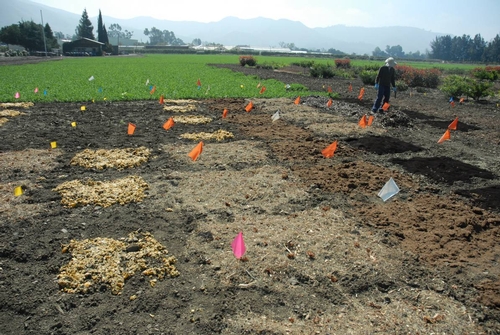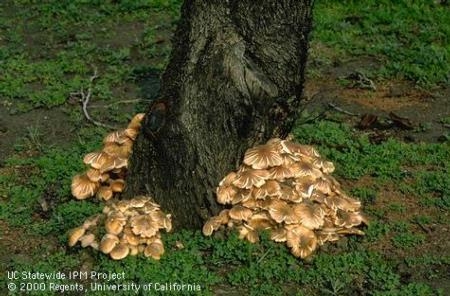
Posts Tagged: Maren Mochizuki
Soil pH reduction at ASHS
Today, Ventura County Cooperative Extension's Maren Mochizuki shares with us about
a local research project.
Preliminary results on the synergistic effect of soil amendments and elemental sulfur to reduce soil pH were presented on Aug. 3 at the ASHS annual conference in Palm Desert, CA. To view the presentation abstract, please click here.
For more information on this project, please see this previous post:

Ground lemon waste, pine needles, peat moss, and coffee grounds applied to soil to ascertain impact on soil pH. Amendments were incorporated using a rototiller.
Aeration holes for nursery pots
Today, Ventura County Cooperative Extension's Maren Mochizuki shares with us about
a local research project.
Do plastic nursery pots with aeration holes improve plant growth compared to standard containers? UCCE Los Angeles Farm Advisor Don Hodel, UCCE Ventura Farm Advisor Jim Downer, and UCCE Ventura Staff Research Associate Maren Mochizuki have recently completed a 3 year study on the effect of four pot types over time on kentia and king palms (number of new leaves, stem caliper size, aesthetic quality, and root dry weight).
Preliminary results were presented on Aug. 3 at the ASHS annual conference in Palm Desert, CA. To view the presentation abstract, please visit http://ashs.confex.com/ashs/2010/webprogram/Paper4301.html.

Aeration holes study. Photo by Jim Downer.
Root rot caused by Armillaria mellea
Today, Ventura County Cooperative Extension's Maren Mochizuki shares with us about
a local research project.
Armillaria mellea is a fungus that causes root rot in citrus, peach, and many other edible tree and landscape species. UCCE Farm Advisors Jim Downer and Ben Faber are investigating the effect of soil disturbance, organic matter, and Trichoderma (another soil fungus) inoculation on survival of peach trees planted in soil infested Armillaria mellea. Preliminary results were presented on Aug. 4 at the ASHS annual conference in Palm Desert, CA.
To view the presentation abstract, please visit: http://ashs.confex.com/ashs/2010/webprogram/Paper4324.html
For more information on symptoms and management of Armillaria mellea, please visit this UC IPM page.

Field shot showing infected tree with bare branches
and yellow leaves caused by Armillaria mellea.

Armillaria mellea
Deep planting of common landscape shrubs and trees at ASHS
Today Maren Mochizuki shares updates with us from a local research project.
Does planting landscape shrubs and trees below grade affect their growth and aesthetic quality? Preliminary results on deep planting were presented on Aug. 4 at the ASHS annual conference in Palm Desert, CA.
To view the presentation abstracts, please visit here and here.
For more information on the shrub project, please see this previous post:

Shrub deep planting plot after three years growth (July 2010).
Scientific meeting format
Today Maren Mochizuki explains how scientific conferences are organized for optimum exchange of ideas and knowledge.
Similar to many other scientific meetings, the ASHS annual conference offers several days of presentations and tours running simultaneously. Sometimes it is a challenge to decide what to attend at any given moment!
Well in advance of the meeting, presenters submit abstracts or brief synopses of their research. Conference organizers use this to determine the credibility of the work and suitability for presentation; once approved, conference attendees use the abstracts to determine which presentations to attend.
The typical format for research presentations is either an oral or poster presentation. In either case, presenters briefly discuss the problem or question they seek to address, research methods and results using photos, graphs, and tables.
Oral presentations are usually conducted using a presentation program such as Microsoft Powerpoint and last 10-12 minutes with an additional 2-3 minutes for questions from the audience. In other oral presentation formats such as colloquia or workshops organized around a particular topic, about 30 minutes may be provided for each presenter to provide more depth.
Posters are typically 3 ft x 4 ft in size and are available for self-paced viewing for the duration of the conference. In addition, each presenter has a one-hour time slot in which he or she is present at the poster to answer questions and interact with other attendees.
At this year’s ASHS Annual Conference, UCCE Farm Advisors and staff conducted three oral presentations and three poster presentations and were co-authors on at least four other oral presentations and two other posters. The research presented will be topics for future posts.
To browse the conference program, please visit http://ashs.confex.com/ashs/2010/webprogram/meeting.html
